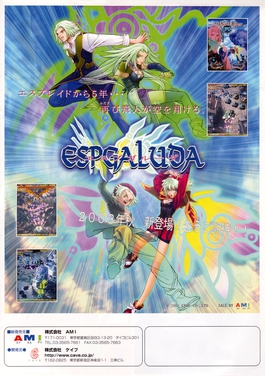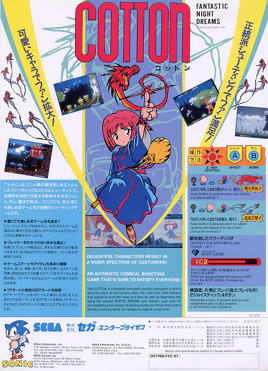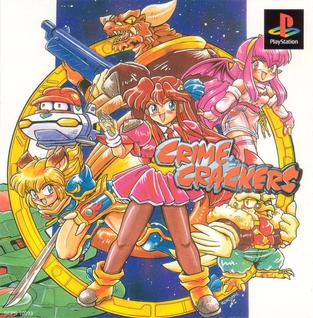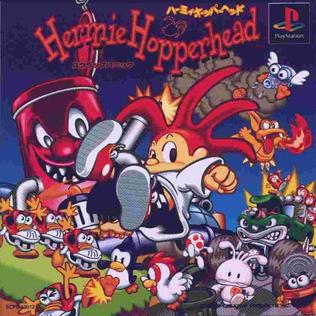
Air Combat is a 1995 combat flight simulation video game developed and published by Namco for the PlayStation. Players control an aircraft and are tasked with completing a series of missions, with objectives ranging from destroying formations of enemies to protecting a specific target from enemy fire. Missions award money that is used to purchase new fighter aircraft, each with its own unique weapons and strengths.

Team Ninja is a Japanese video game developer, and a division of Koei Tecmo, founded in 1995 as a part of Tecmo. It was founded by Tomonobu Itagaki, and is best known for franchises such as Ninja Gaiden, Dead or Alive and Nioh.

Espgaluda is a 2003 manic shooter by Cave and published by AMI. It is the spiritual successor to ESP Ra.De. and is followed by Espgaluda II.

Pain is an action video game developed by Idol Minds and published by Sony Computer Entertainment for PlayStation 3. It was released as a downloadable title available from the PlayStation Store and was released in North America on November 29, 2007 and in the PAL region on March 20, 2008 and became the most popular downloadable game on the PlayStation Store. In June 2009, SCEE announced that the game was to be released on Blu-ray Disc. It was launched in Europe on June 24, 2009, in Australia on June 25, 2009 and in the UK on June 26, 2009. The Blu-ray version includes the original game as well as several other levels and features released as downloadable content for the PSN version. It is available in a collection which is available to download from the PlayStation Store called the 3D Collection. On November 26, 2013, the game's online features were disabled.

MotorStorm: Pacific Rift is a racing video game by Evolution Studios and published by Sony Computer Entertainment for the PlayStation 3. It is the sequel to MotorStorm and is followed by MotorStorm: Arctic Edge for the PlayStation 2 and PSP, and MotorStorm: Apocalypse. The game was announced by Sony after their acquisition of Evolution Studios and it was released on 28 October 2008 in North America. The game sold over one million units as of 9 December 2008. As of 1 October 2012, the online servers for the game have been permanently shut down.

Cotton: Fantastic Night Dreams is a scrolling shooter video game developed by Success and originally released in Japanese arcades in 1991. The first installment in the Cotton series, players assume the role of the young witch Cotton who, alongside her fairy companion Silk, sets out on her broomstick on a quest to defeat several monsters and get her Willow candy. Its gameplay mainly consists of shooting mixed with role-playing game elements using a main two-button configuration. It ran on the Sega System 16 hardware.
Japan Studio was a Japanese video game developer based in Tokyo. A first-party studio for Sony Interactive Entertainment, it was best known for the Ape Escape, LocoRoco, Patapon, Gravity Rush, and Knack series, the Team Ico games, Bloodborne, The Legend of Dragoon, and Astro's Playroom. In April 2021, Japan Studio was reorganized and merged with Team Asobi and other SIE studios.

Army of Two: The 40th Day is a third-person shooter video game developed by EA Montreal and published by Electronic Arts for PlayStation 3 and Xbox 360. The game was also released for PlayStation Portable, which was developed by Buzz Monkey. It is the sequel to Army of Two. Army of Two: The 40th Day was released in 2010 worldwide.

3D Dot Game Heroes is an action role-playing video game developed by Silicon Studio for the PlayStation 3. The game is presented using voxel-based graphics in a 3D environment to emulate the 2D graphics of earlier video games. The game was published in Japan by FromSoftware in November 2009, and in North America and Europe by Atlus USA and SouthPeak Games in May 2010, respectively.

Resistance 3 is a 2011 science fiction post-apocalyptic first-person shooter developed by Insomniac Games and published by Sony Computer Entertainment for the PlayStation 3. Resistance 3 is the final installment in the Resistance trilogy. Resistance 3 is the first in the series to support 3D and PlayStation Move and was the first to introduce the PSN Pass program. The game shifts away from the military aspect of Resistance: Fall of Man and Resistance 2 and takes on a post-apocalyptic survival-horror feel.

PlayStation Move Ape Escape, simply titled Ape Escape in Europe and known in Asian countries as Ape Escape: On the Move!, and in Japan as Furi Furi! Saru Get You, is a 2010 rail shooter and party video game developed by Sony Computer Entertainment's Japan Studio and published by Sony Computer Entertainment for the PlayStation 3 video game console. The game was originally announced at the Tokyo Game Show 2009 as one of the title supporting the PlayStation Move controller. The title was released on December 9, 2010, in Japan, then in 2011 on June 24 for Europe, and on July 5 for North America. An English version of the game in Asia was also released January 31, 2011.

Start the Party! is a 2010 augmented reality party video game for the PlayStation 3. It utilizes the PlayStation Move controllers. It is the first game developed by Supermassive Games and was published by Sony Computer Entertainment for release as a launch title for the PlayStation Move. The game is a collection of augmented reality mini-games which use the PlayStation Eye.

Sports Champions is a 2010 sports video game developed by San Diego Studio and Zindagi Games and published by Sony Computer Entertainment for PlayStation 3, which utilizes PlayStation Move. It was officially unveiled at the 2010 Game Developers Conference in San Francisco. The game is a collection of modern and medieval sports games published by Sony Computer Entertainment and was jointly developed by San Diego Studio and Zindagi Games as a launch game for the PlayStation Move which would be bundled with the controller in several regions.

Kung Fu Rider, known in Japan as Matchi Suberi, and previously known as Slider, is an action video game for the PlayStation 3. The game was developed by Japan Studio and published by Sony Computer Entertainment for use with the PlayStation Move controller. It was officially unveiled at the 2010 Game Developers Conference in San Francisco. It was released in 2010, and received mostly negative reviews from critics.

TV Superstars is a party video game for the PlayStation 3, which uses the PlayStation Move motion controller. The game was developed by SCE Cambridge Studio and published by Sony Computer Entertainment.

Time Crisis: Razing Storm, known in Japan as Big 3 Gun Shooting, is a compilation of light gun rail shooter video games by Namco for the PlayStation 3. Featuring full compatibility with both the GunCon 3 light gun and the PlayStation Move motion control system, the compilation consists of ports of various arcade games. Developed by Nex Entertainment and published by Namco Bandai Games, the compilation was released in 2010 in North America on October 19, and in Japan on October 21, which is the launch date of the PlayStation Move in Japan. It was released as part of a bundle with the PlayStation Move, PlayStation Eye and the Shooting attachment for the PlayStation Move in Japan and other Asian countries.

Eschatos is a scrolling shooter, developed and published by Qute, which was released on April 7, 2011 for the Xbox 360. Despite the original Xbox 360 version only being released in Japan, it was a region-free release. A version for Microsoft Windows, published by Degica, was released in 2015. In 2021, Eschatos was ported to the Nintendo Switch exclusively in Japan, and was released worldwide on the Switch and PlayStation 4 the following year. Apart from the main game, two previous Wonderswan games by the developer, Judgement Silversword and Cardinal Sins, came bundled with the Xbox 360 release of Eschatos.

Helldivers is a 2015 top-down shooter game developed by Arrowhead Game Studios and published by Sony Computer Entertainment. The game was released for PlayStation 3, PlayStation 4, and PlayStation Vita in March 2015. A version for Windows was also released on 7 December 2015, making it the first Sony published game for PC.

Crime Crackers is a first-person shooter/action role-playing video game developed by Media.Vision and published by Sony Computer Entertainment for the PlayStation. Based on a science fiction manga set after an intergalactic war, the story follows of group of bounty hunters aboard the spacecraft Pink Dolphin as they take on jobs requested by the Galactic Federation police. Gameplay resembles dungeon crawlers, largely consisting of exploring complex 3D corridors, collecting items, and shooting enemies. The player is able to freely rotate between three unique characters within missions, while points earned afterwards can be used to purchase consumable items and upgraded equipment.

Hermie Hopperhead: Scrap Panic is a platform video game developed by Yuke's and published by Sony Computer Entertainment for the PlayStation. It was released in Japan in September 1995. The game uses parallax scrolling.




















